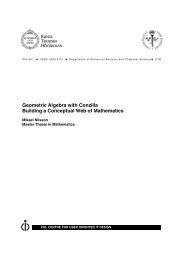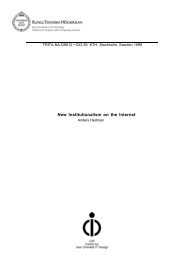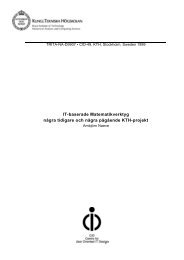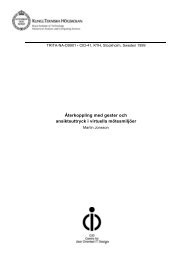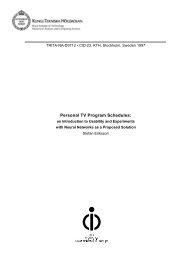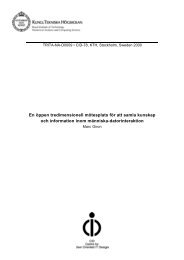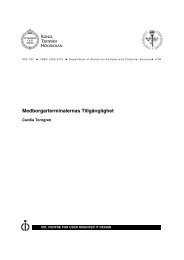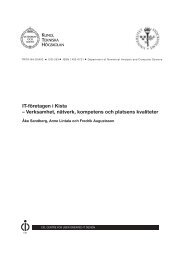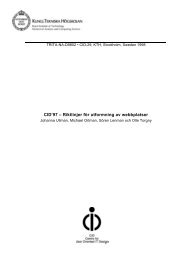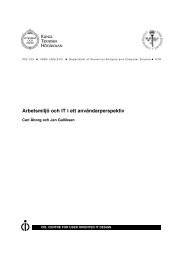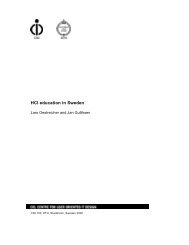Video Mediated Communication (VMC) - Producing a ... - CID - KTH
Video Mediated Communication (VMC) - Producing a ... - CID - KTH
Video Mediated Communication (VMC) - Producing a ... - CID - KTH
You also want an ePaper? Increase the reach of your titles
YUMPU automatically turns print PDFs into web optimized ePapers that Google loves.
<strong>CID</strong>-206 ISSN 1403-0721 Department of Numerical Analysis and Computer Science <strong>KTH</strong><strong>Video</strong> <strong>Mediated</strong> <strong>Communication</strong> (<strong>VMC</strong>) - <strong>Producing</strong> a senseof presence between individuals in a shared virtual realityClaus J. KnudsenProc. of the International Symposium on Educational Conferencing(ISEC 2002), May 31 - June 1, 2002<strong>CID</strong>, CENTRE FOR USER ORIENTED IT DESIGN
<strong>CID</strong>-206 ISSN 1403-0721 Department of Numerical Analysis and Computer Science <strong>KTH</strong><strong>Video</strong> <strong>Mediated</strong> <strong>Communication</strong> (<strong>VMC</strong>) - <strong>Producing</strong> a senseof presence between individuals in a shared virtual realityClaus J. KnudsenProc. of the International Symposium on Educational Conferencing(ISEC 2002), May 31 - June 1, 2002<strong>CID</strong>, CENTRE FOR USER ORIENTED IT DESIGN
Claus J. Knudsen<strong>Video</strong> <strong>Mediated</strong> <strong>Communication</strong> (<strong>VMC</strong>) - <strong>Producing</strong> a sense of presence between individuals ina shared virtual realityProc. of the International Symposium on Educational Conferencing(ISEC 2002), May 31 - June 1, 2002Report number: <strong>CID</strong>-206ISSN number: ISSN 1403 - 0721 (print) 1403 - 073 X (Web/PDF)Publication date: May-June 2002E-mail of author: clausk@kth.seReports can be ordered from:<strong>CID</strong>, Centre for User Oriented IT DesignNADA, Deptartment of Numerical Analysis and Computer Science<strong>KTH</strong> (Royal Institute of Technology)SE- 100 44 Stockhom, SwedenTelephone: + 46 (0)8 790 91 00Fax: + 46 (0)8 790 90 99E-mail: cid@nada.kth.seURL: http://cid.nada.kth.se
<strong>Video</strong> <strong>Mediated</strong> <strong>Communication</strong> (<strong>VMC</strong>)<strong>Producing</strong> a sense of presence between individuals in a shared virtual realityClaus J. KnudsenDivision of Media Technology and Graphic Arts, Dept. of Numerical Analysis and Computing Science (NADA),Royal Institute of Technology (<strong>KTH</strong>), Lindstedsvägen 5, SE-100 44 Stockholm, Sweden (Tel: +46-8-790 6376;Fax: +46-8-791 8793; E-mail: clausk@kth.se)Abstract. One of the main objectives of the use of video mediated distance communication is the production ofa sense presence and togetherness between the participants as well as a shared sense of space. In a series of testcasestudies with asynchronous and synchronous distance techniques we have seen that the feeling ofparticipation and presence are less dependent on technological fidelity factors than on dramaturgy andstorytelling techniques.An experienced sense of presence and immersion can be produced with relatively simple technical means. In thispaper a communication model, a set of determining factors of presence, and examples from a test-case study arepresented.Keywords: Virtual reality, video, media, communication, storytelling, narration, distance communication.1. INTRODUCTIONIn this paper I hope to contribute to the discussions on the building of models for comparisonof research results within video mediated communication. I also want to pay tribute to allcreative use of moving images and audio, contributing to the sense of presence, emotion, trustand confidence, these basic needs in life.2. A COMMUNICATION MODEL – the telepresence viewA definition of video communication, not based on technology, might be needed to permitvariation across technologies along a number of dimensions as video technology changes andbecomes one of many mediators. The traditional communication model [1] may preferably bereplaced by the communication model of Steuer after Krueger [2].The Traditional<strong>Communication</strong> ModelABTelepresence ViewVirtualrealityABFigure 1 Two models of mediated communication between A and B,the Traditional <strong>Communication</strong> Model and "The Telepresence View"1
In this model the term “Virtual reality” is tied to an experience rather than to a machine. Thiscan be the experience of being together in a shared virtual environment. Telepresence isdefined as the subjective experience of being together in one place when one isgeographically situated in another (after the classic paper by Minsky) [3]. According to themodel, telepresence or presence can be experienced through virtually any technology used inmediated communication. Newspapers, letters, and magazines place the reader in a space inwhich the writer is telling a story; television places the viewer in a virtual space in which bothviewer and on-screen objects are present; and video games create virtual spaces in which thegame-player is an actor [2].3. THE BUILDING BLOCKS OF PRESENCE PRODUCTIONEnlund proposes three basic factors that determine the sense of presence and reality in theconsumer, or receiver, of virtual reality products or services: the sensory environment, theindividual preconditions present, and the characteristics of the content delivered [4]. Figure 3illustrates these factors and it is suggested that these factors can be further sub-dividedaccording to the dimensions of Steuer and others.SensoryenvironmentVividnessInteractivity and controlCompany of "others"DepthBreadthSense of presenceand realityIndividualpreconditionsContentcharacteristicsImaginationEmotional stateAssociative contextSuspension of disbeliefPlot and storyNarration and dramaturgyPresentation and executionFigure 2 Factors creating a sense of presence and reality [4].The producer of virtual reality may mainly influence the sensory environment and the contentcharacteristics, although, e.g., special designed physical entrances to virtual realityperformance spaces may influence the individuals’ emotional state. But still the producers ofvirtual reality or presence should concentrate their efforts on the technical skills needed toimprove the sensory environment for the users as well as on learning how to produce qualitycontent that will support the creation of a strong sense of presence and reality [5].4. EXAMPLES FROM A TEST-CASE STUDYThe main goal of the test case studies was to investigate presence through a set of differentcontexts experimenting with shared person and/or task spaces [6]. The content of a coursegiven jointly at the Royal Institute of Technology (<strong>KTH</strong>) in Stockholm, Sweden and GjøvikUniversity College in Norway called Telepresence production [7] is related to the continuousongoing investigation on the phenomenon of presence. From 1997 to 2002, more than 300students have been learning about storytelling, results from presence research and2
characteristics of different distance technologies in order to gather basic knowledge for theirprojects and exams. Practical examples were presented in lectures given both at a distancefrom Sweden and locally in Norway. The students` project-based exams, lectures and tutoringhave been used as a test bed for new development, experiments, observation and analysesconnected to presence research work [8], e.g. questionnaires for measuring ImmersiveTendencies (ITQ), Presence (PQ) and Social Presence (SPQ) [9]. The courses have, ingeneral, been “meta” courses, using video mediated presence from Stockholm to teach thestudents in Norway about the main principles of producing video mediated presence.The experiments can be summarised by the types of exam projects that the remote students atGjøvik University College have undertaken:• Games, competitions, e.g. “Who wants to be a millionaire?” and “bit by bit”, a gamebetween two competing groups at a distance trying first to recognize an object comingup on the computer screen piece by piece.• Instruction, e.g. software education or support, origami, LEGO building, guitarplaying, card tricks and computer work ergonomics.• Role play and ceremonies, e.g. court trials, and theatre plays, such as “Superman”.• Multipoint cooperation, e.g. controlling a building process and composition of music.• Interactive information packages, e.g. interactive TV news and travel agency services.The results of the experiments indicate that many factors such as good storytelling, interactionand control let the participants forget the existence of a medium during the low budgettechnological mediated experience – the experience of the perceptual illusion of nonmediationdefined as presence by Lombard and Ditton [10].Role play and cermonies – a virtual marriageI will here present in more detail an experiment related to role play and ceremonies – thevirtual marriage. In this exam production three physical spaces were interconnected withvideo and audio communication on ISDN (256 Kbps) and direct links. The synopsis describeda couple wishing to get married but because the bridegroom was in prison (space A) andcould not physically be present in the church with his bride (Space B) they had decided toSpace ASharedvirtualrealitySpace CSpace BFigure 3 Virtual marriage - video mediated togetherness in a “virtual church”.3
carry out the ceremony at a distance. The “minister”, willing to marry them, was inStockholm (Space C).Simple color-key techniques were used to mix the person in space A into space B. Thesecondary monitors supported the transmission of gaze, gesture and facial expressionsbetween the couple and the “minister”. The distance techniques also supported eye-contactbetween the participants, and the motivation for the selected composition of the differentimages were compensating for differences of screen sizes and body placement used in thecommunication. The speed of interaction, also called response time between the participants,was less than 200 mS and acceptable for the video mediated communication skill [11]. Themeans of expression considered relevant for the experiment – the elements of the narrative –could be divided into two categories: those belonging to the Plan of Event (How we see andhear as we interact) and those belonging to the Plan of Discourse (What we see and hear aswe interact) [12].The participants reported a strong emotional experience of togetherness in the shared virtualspace, the “virtual church”. The results from this experiment and also from other studiessupport the hypothesis that even simple technology may be used to achieve a good sense ofpresence and reality at a distance. The key factor seems to be storytelling and with goodstorytelling even simple technology works [5].Figure 4 A computer generatedshared virtual reality “person space”.Figure 5 A video mediated sharedvirtual reality “task space”.Figure 3 and 4 are pictures from another exam project called “Estonian Easter traditions”. Oneinterpreter is seen as a living picture on the wall in the “traditional” room behind theNorwegian and Estonian girls dressed in national costumes. Three geographically separatedspaces with participants were, in this production, interconnected including the interpreter, thegirls and two participants in Stockholm, not visible in figure 3 but sitting in front of the table.The interpreter translates the dialogue in the room and the girl to the left turns her head, as isnatural in a real situation, to pay attention when the other girl talks. In figure 4, color-keytechnology has been used to share a common task space for “egg rolling”. The hand on theleft belongs to the participant in Stockholm and the girl on the right is sitting in Norway.The results from the exam indicated a strong sense of presence and reality both related to theshared virtual person space and the shared virtual task space. Again, quite simple technologywas used and storytelling seemed to be the most important factor for creating presence.5. CONCLUSIONThe basic factors producing feelings of presence and reality in virtual reality or mediaapplications and services are related to sensory environment, individual preconditions andstorytelling. The key factor is storytelling. With good storytelling, even simple technology4
works. This is best illustrated by the simple fact that a tale well told will transport theaudience into “another world” even if the medium is “low tech”, e.g., a traditional book or abedtime story read aloud” [4], [5], [7], [13].6. ACKNOWLEDGEMENTSThanks to my professor Nils Enlund and colleagues at the <strong>KTH</strong> research group for mediatechnology in Stockholm, Sweden [14] and my students and colleagues at Gjövik UniversityCollege, Norway, for their work and inspiration [15]. Also thanks to senior researcher andhead of <strong>CID</strong>s` Knowledge Management Research Group Ambjørn Naeve for discussions andtests modeling determinants of presence using a “dialect” of the Unified Language Modelingstandard (UML) [16].7. REFERENCES[1] DeFleur, M. & Ball-Rokeach, S. , Teories of mass communication, New York: Longman, 5 th ed., 1989.[2] Steuer J., Defining Virtual Reality: Dimensions Determining Telepresence, Journal of <strong>Communication</strong>, Autumn, 1992,pp. 73-93.[3] Minsky, M., Telepresence, Omni, June 1980, pp. 45-51.[4] Enlund, N., The Production of Presence - Distance techniques in Education, Publishing and Art, ACS'2000 Proceedings,Szczecin, 2000, pp. 44-49.[5] Enlund, N., Beeing Virtually There - Reality and Presence in <strong>Mediated</strong> Learning, Proceedings of theTelecommunications for Education and Training Conference, TET 2001, Sponberg H. et al. (Eds.), Charles University,Prague, Czech Republic., May, 2001, keynote-paper.[6] Buxton, W., Telepresence: Integrating Shared Task and Person Spaces, Groupware `91 Proceedings, Amsterdam,October, 1991, pp.27-36.[7] Handberg, L., Knudsen C., Sponberg H., New Learning modes in the production of presence – distance techniques foreducation, Proceedings of the 20 th World Conference on Open Learning and Distance Education, ICDE01, Düsseldorf,2001, on Compact Disc.[8] Witmer B. G. and Singer M. J., Measuring presence in virtual environments, a Presence Questionnaire, MIT PresenceJournal, Volume 7, Number 3, 1998.[9] Presence research site on the Internet, URL: http://www.presence-research.org/.[10] Lombard, M., Ditton, T.: ”At the heart of it all: The concept of presence”, Journal of Computer <strong>Mediated</strong> <strong>Communication</strong>,Vol. 2, Nr. 3, 1997.[11] Angiolillo J. S. et. al., Technology Constraints of <strong>Video</strong>-<strong>Mediated</strong> <strong>Communication</strong>, in Kathleen, F. E. et al. (eds.),<strong>Video</strong>-<strong>Mediated</strong> <strong>Communication</strong>, Lawrence Erlbaum Associates, New Jersey, Book, 1997, pp. 51-73.[12] Foss B., Filmmaking Narrative and Structural Techniques, Silman-James Press, Hollywood, California, 1992, pp. 16-45.[13] Reeves, B., Nass, C.: The media equation, Cambridge University Press, Cambridge, 1996.[14] Media Technology and Graphic Arts Research Group, Royal Institute of Technology (<strong>KTH</strong>), Stockholm, Sweden, URL:http://www.gt.kth.se.[15] Gjøvik Univesity College, Gjøvik, Norway, URL: http://w3.hig.no/grafisk/mainenglish.html.[16] Knowledge Management Research Group, Centre for Interactive IT Design (<strong>CID</strong>), Royal Institute of Technology(<strong>KTH</strong>), Stockholm, Sweden, URL: http://kmr.nada.kth.se.5



